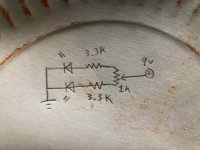You are using an out of date browser. It may not display this or other websites correctly.
You should upgrade or use an alternative browser.
You should upgrade or use an alternative browser.
Double status LED
- Thread starter SYLV9ST9R
- Start date
Bricksnbeatles
Member known well
*technically* either way works, but my preferred method is to put them in parallel with a slightly smaller than usual CLR (they both get their own CLR), along with a 1kohm trim pot (I’ll draw up a schematic to demonstrate). LEDs are pretty inconsistent I’ve found, so one will likely be slightly brighter than the next even when directly swapped for each other. By having the trimpot, you can very effectively match the light output by both LEDs so they’re perfectly matched. A little bit overkill, but hey, it works.Quite a simple question, but with some searching, not sure about the the answer.
I want to put 2 status LED on a build, and I'm not sure how to wire them.
Series? Parallel? Should I change the CLR value?
Any hindsight would be much appreciated.
SYLV9ST9R
Well-known member
Thanks.You'll want to wire them in parallel, each with their own CLR.
I assume I just jumper the CLR on the board then?
SYLV9ST9R
Well-known member
Thanks. I’ll start with the simple approach as it’s in an already crowded 1590A, but I’ll keep this in my notes for future builds!*technically* either way works, but my preferred method is to put them in parallel with a slightly smaller than usual CLR (they both get their own CLR), along with a 1kohm trim pot (I’ll draw up a schematic to demonstrate). LEDs are pretty inconsistent I’ve found, so one will likely be slightly brighter than the next even when directly swapped for each other. By having the trimpot, you can very effectively match the light output by both LEDs so they’re perfectly matched. A little bit overkill, but hey, it works.
Bricksnbeatles
Member known well
Please excuse the fact that it’s poorly drawn on a paper plate that I used as a spraypaint backdrop. Here it is, drawn up as promised. I use a 3.3K resistor for each LED, for a total of roughly 3.8k (half of the 1k trimmer) for each led, but you can play around with other values to get the brightness you like, I’d just recommend staying at 1k with the trimmer since anything more would be overkill and contribute too much additional dimming to the led, but in rare occasions some LEDs won’t be balanced until it’s near one of the far ends of the trimmer (20/80% rotation at most, but it’ll usually be very very close to the middle)*technically* either way works, but my preferred method is to put them in parallel with a slightly smaller than usual CLR (they both get their own CLR), along with a 1kohm trim pot (I’ll draw up a schematic to demonstrate). LEDs are pretty inconsistent I’ve found, so one will likely be slightly brighter than the next even when directly swapped for each other. By having the trimpot, you can very effectively match the light output by both LEDs so they’re perfectly matched. A little bit overkill, but hey, it works.
Attachments
SYLV9ST9R
Well-known member
The parallel method will work better, as I want 2 LED for the design (eyes on a skull, I know, not the most original designI have used a bicolour LED with a common anode for this purpose which is easier to wire in and position. Would this work for you? The beavis order switcher shows it best. I’ll find the picture.
JamieJ
Well-known member
Ah okay, apologies. I misunderstood.The parallel method will work better, as I want 2 LED for the design (eyes on a skull, I know, not the most original design).
SYLV9ST9R
Well-known member
No worries there, better more knowledge than none!Ah okay, apologies. I misunderstood.
Hope you don’t feel too sore from your accident.
JamieJ
Well-known member
Thanks! Feeling loads better and more human today which is good.No worries there, better more knowledge than none!
Hope you don’t feel too sore from your accident.



